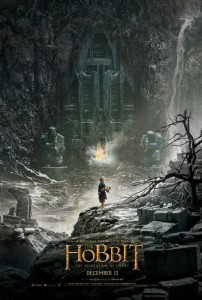 So, disclosure: I saw this movie a couple months ago on cable, but since I saw all three movies in a marathon on Monday, have never reviewed this one, and it would be weird to review two out of three, here we are.
So, disclosure: I saw this movie a couple months ago on cable, but since I saw all three movies in a marathon on Monday, have never reviewed this one, and it would be weird to review two out of three, here we are.
Of course, The Desolation of Smaug is hard to review in this context as well, piled in as it was within 9 or 10 combined hours of movie. So I guess it’s a good thing I had seen it one time before. And… so, okay, if you’ve read the book, you more or less know what happens in the movies, right? So I can say things like the scenes in Mirkwood made a little more sense than I remember[1], or the barrel ride to Laketown was just ridiculously hyper-extended, and you’ll know the flavor if not the details of what I mean.
That said, before I move into more (but still light) spoiler territory, it is incumbent upon me to mention that as part of a continuous unit, the stretched out scenes, where they existed at all, did not bother me as much as I had remembered from October. There should still probably be two movies here instead of three, but given the Hollywood constraints Tolkien didn’t have to deal with[2], they’d have probably been two oddly paced movies. So perhaps this wasn’t so bad.
Anyway, as far as differences between the book and what’s on film, I have two comments. First, the love story. Was it shoehorned in? Yes, absolutely. Not in a way that made it feel unnatural or unbelievable, just in a way that made no nod to necessity. But The Lord of the Rings had a love story, and S. Morganstern notwithstanding, nobody writes kidbooks that contain both adventure and a love story. So I see from Jackson’s perspective why he felt it was necessary for balance purposes. I mean, barely, but I see it.
Second, Gandalf. It really seems like someone should have realized that you don’t capture him and then leave him to hang out until one of his friends rescue him. Yes, yes, this is a longstanding trope, and yes, yes, Tolkien needed him out of the way of the plot sometimes, since he is functionally a deus ex machina in himself, if left to his own devices. But man, when you have the same circumstance and outcome twice in consecutive book series, either you are David Eddings or you need to feel bad about yourself the second time.
So, that was the second movie.
[1] Because, really, how hard is it to stay on a damn road?
[2] To wit: motivation. You can tell kids in a kidbook that the goblins and orcs are chasing the dwarves all over the place just because goblins and orcs are bad guys who do that, and it’s good enough. But he wanted to make a) not a kid movie that b) tied into the Lord of the Rings in all the ways Tolkien knew about and Bilbo did not. So you have to[3] establish leader orcs with names and motivations and backstories to the main character, and have them interact with the Necromancer’s long term plans, even though you know they’re just going to be thwarted and it ultimately will all keep until your sequel movie filmed 60 or 80 years later, in 2001.
[3] Or, okay, you don’t have to, but clearly that’s what Peter Jackson had in mind, and I don’t begrudge him the behind the scenes portions, since they were relevant to explaining things like why Gandalf is missing all the time, plus, like I said (or maybe haven’t said yet, depending on how you personally interact with footnotes), tying into that sequel.